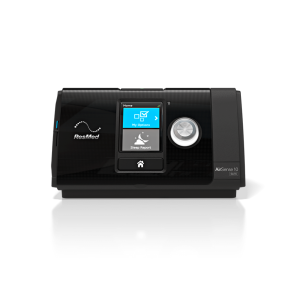Fact Checked
Intus Healthcare’s writers, customer service team, and sleep experts review and ensure this information is accurate.
Last updated on January 29th, 2024 at 10:39 am
What is a CPAP machine?
CPAP stands for Continuous Positive Airway Pressure, and a CPAP machine is the most commonly used treatment for Obstructive Sleep Apnoea.
Obstructive Sleep Apnoea (OSA) is a sleep disorder in which a person’s breathing repeatedly stops and starts during sleep. It is caused by a physical blockage of the airway, usually when the soft tissue in the back of the throat collapses and closes during sleep. Symptoms of OSA include loud snoring, frequent pauses in breathing, gasping for breath, and daytime sleepiness. Treatment usually involves lifestyle changes, such as avoiding alcohol or weight loss management and using a CPAP machine.
A CPAP machine would be prescribed by a doctor or a recommended treatment method after taking a Sleep Apnoea test.
CPAP machines deliver continuous pressurised air through to your nose or mouth via a CPAP tube into a CPAP mask. The continuous flow of pressured air prevents your airway from collapsing at night. The pressurised air pushes against blockages; therefore, you do not experience pauses in breathing. As you no longer have repetitive drops in your oxygen levels, you wake up feeling refreshed.
How does a CPAP machine work?
A CPAP machine consists of:
- The motor: This is the device itself that sits at your bedside. Delivering quiet pressurised air, taken from the room. The pressurised air is delivered through a CPAP hose into your airway through a CPAP mask. You can add a CPAP humidifier to your therapy. How does a humidifier improve CPAP therapy? A humidifier warms and moistens the air and adds extra comfort.
- CPAP hose: The hose connects the machine to your mask, typically 6ft long. A heated tube can be added to your therapy to keep the air warm and improve comfort (if humidification is already being used).
- CPAP mask: The type of mask you need for CPAP therapy is determined by your breathing and sleeping patterns. A full-face mask is for those who breathe through their nose and mouth at night. A nasal cushion
What are the different types of CPAP machines?
There are three types of breathing machines, APAP, CPAP and BiPAP; they are all very similar.
Let’s compare CPAP vs BiPAP vs APAP:
Stands for Continuous Positive Airway Pressure; these machines can be set to a fixed pressure mode between 4-20cmH2O. A fixed pressure setting has to be determined by your doctor or sleep clinic, OR these machines can be set to an automatic pressure that automatically changes throughout the night – known as APAP (Automatic Positive Airway Pressure). They also adjust between the pressure of 4-20cmH2O, allowing a comfortable nights’ sleep.
There are a variety of CPAP machines to choose from; the ResMed AirSense 10 is a popular device, as well as the Prisma SmartPlus.
BiPAP – Stands for BiLevel Positive Airway Pressure, typically operating the pressure setting between 4 and 25cmH2O. These machines have adjustable pressure settings for inhaling and exhaling:
- When you breathe in, the BiPAP machine delivers more pressurised air, known as Inspiratory Positive Airway Pressure (IPAP).
- When you breathe out, the BiPAP machine delivers a reduced amount of pressured air, known as Expiratory Positive Airway Pressure (EPAP).
BiPAP machines are an alternative for people that cannot use a CPAP or APAP machine. Your doctor will recommend a BiPAP machine if it is necessary.
What are BIPAP machines used for?
BiPAP machines are commonly used to treat:
- Chronic Obstructive Pullimary Disease (COPD)
- Congestive heart failure
- Obesity hyperventilation syndrome
- A neurological or neuromuscular disorder
- Obstructive Sleep Apnoea (OSA)
Read more: CPAP vs BiPAP: What is the difference?
What are the pros and cons of using a CPAP machine?
Like everything, there are always two sides to the coin. It is good to remember that the benefits by far outweigh the negatives when using CPAP therapy.
CPAP therapy health benefits
Treating your Sleep Apnoea with a CPAP machine can improve your symptoms, such as snoring and choking in sleep. But there are other health conditions that CPAP helps with:
- Depression and Anxiety: Studies show that CPAP can improve mental health(1).
- Type 2 Diabetes: You’re at a higher risk of developing type 2 diabetes with Obstructive Sleep Apnoea(2). Using a CPAP machine reduces the risk.
- Heart Disease: A study found that using a CPAP machine decreases cardiovascular events in those with coronary artery disease(3).
- Stroke risk reduction: Studies show that using a CPAP machine is associated with a lower risk of developing a stroke(4).
- Atrial Fibrillation: Those with Sleep Apnoea are four times more likely to develop atrial fibrillation(5). Those with atrial fibrillation and Sleep Apnoea using a CPAP machine are less likely to have a reoccurrence of the heart disorder.
Side effects of a CPAP machine
Some problems can occur when using CPAP therapy. Let’s take a look at some common side effects.
Red marks and skin irritation from CPAP masks: Many people come across red marks from their CPAP masks. This can be due to a poor-fitting mask or a skin allergy.
CPAP mask leaks: Air leaks from a CPAP mask can irritate you and your bed partner throughout the night. Usually, this is because the mask does not fit properly, or a change in your sleeping position dislodges your mask. Sometimes tightening your headgear will relieve you of this issue. You could also consider a CPAP pillow to prevent your mask from moving from your face.
A dry mouth or nose: Some CPAP users suffer from a dry mouth due to mask leaks. You could try a more suitable mask or add humidification to your therapy to moisten the pressurised air.
Can I buy a CPAP machine?
People often ask if they can buy a CPAP machine without a prescription? To purchase a device from us, you need to have Sleep Apnoea confirmed first. You can do this by taking a private sleep study or a sleep study through a sleep clinic. If you think you have OSA and have not had it confirmed, take you can take our in-home sleep test and have a result in as little as 7-10 working days.

At-Home Sleep Study
Our detailed In-Home Sleep Test uses the revolutionary WatchPAT diagnostic device. The WatchPAT device offers similar accuracy to Polysomnography (PSG), which is a comprehensive sleep study conducted in sleep laboratories for detailed sleep analysis. However, the WatchPat device provides the convenience and comfort of being used at home.
The device monitors blood oxygen levels, actigraphy, chest motion, heart rate, body position, snoring intensity, and, crucially, your Peripheral Arterial Tone, a key physiological signal indicating respiratory disturbances during sleep.
The information it records gives our sleep technicians a comprehensive picture of your sleep, allowing them to provide an accurate report.
Contact us if you need any help or advice on taking a sleep test or buying a CPAP machine.
Additional resources
9 Common CPAP Machine Side Effects & How To Fix Them
REFERENCES
- Gupta, M.A. and Simpson, F.C. (2015) ‘Obstructive sleep apnea and Psychiatric Disorders: A systematic review’, Journal of Clinical Sleep Medicine, 11(02), pp. 165–175. doi:10.5664/jcsm.4466. Accessed: 15.08.2023
- Doumit, J. and Prasad, B. (2016) ‘Sleep apnea in type 2 diabetes’, Diabetes Spectrum, 29(1), pp. 14–19. doi:10.2337/diaspect.29.1.14. Accessed: 15.08.2023
- Milleron, O. (2004) ‘Benefits of obstructive sleep apnoea treatment in coronary artery disease: A long-term follow-up study’, European Heart Journal, 25(9), pp. 728–734. doi:10.1016/j.ehj.2004.02.008. Accessed: 15.08.2023
- Wickwire, E.M. et al. (2021) ‘CPAP adherence is associated with reduced risk for stroke among older adult Medicare beneficiaries with obstructive sleep apnea’, Journal of Clinical Sleep Medicine, 17(6), pp. 1249–1255. doi:10.5664/jcsm.9176. Accessed: 15.08.2023
- Latina, J.M., Estes, N.A. and Garlitski, A.C. (2013) ‘The relationship between obstructive sleep apnea and atrial fibrillation: A complex interplay’, Pulmonary Medicine, 2013, pp. 1–11. doi:10.1155/2013/621736. Accessed: 15.08.2023










